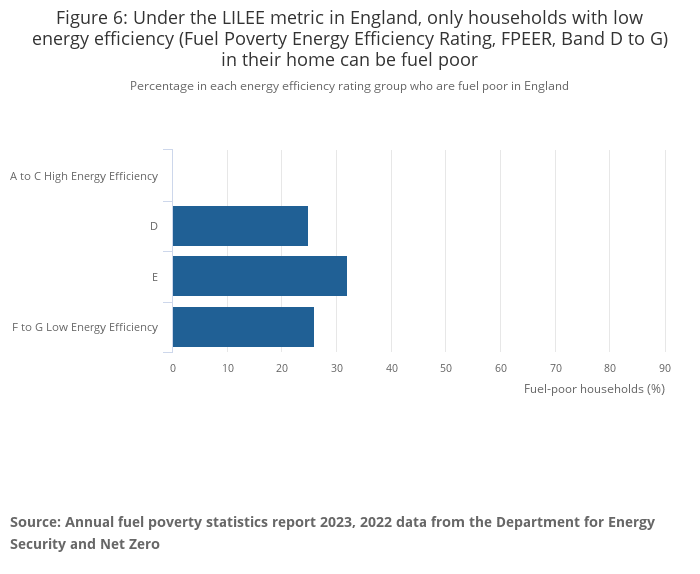
Times remain uncertain when it comes to the provision of energy. Homes throughout the UK are unfortunately and continually struggling to meet the financial demands of heating their homes. As such, fuel poverty has become a more frequently discussed topic. However, we first need to ask, what is fuel poverty? And does external wall insulation have a part to play?
The House of Commons Library Fuel Poverty document, as part of the UK Government, defines fuel poverty as the following:
"In England, the Government introduced a new definition of fuel poverty in 2021. This is the ‘Low-Income Low Energy Efficiency’ (LILEE) definition of fuel poverty. Here a household is fuel-poor if:
- They are living in a property with an energy efficiency rating of band D, E, F or G
- Their disposable income (income after housing costs and energy needs) would be below the poverty line.
The depth of fuel poverty is measured by the fuel poverty gap -the reduction in fuel costs needed for a household to not be in fuel poverty. Only those households in band D-G homes who fall below the poverty line after energy costs are considered as being in fuel poverty." (Fuel Poverty in the UK)
FPEER, LILEE, and the History of fuel poverty
The term fuel poverty crops up initially in the 2001 Fuel Poverty Strategy. The document defines it as needing to spend in excess of 10% of household income on fuel use to achieve satisfactory heating. This definition has since become more fluid and devolved. As such, England, Scotland, Wales, and Northern Ireland all have slightly different definitions. However, the concept remains the same. The concerns are related to energy efficiency, household income, and energy prices. With energy prices at all-time highs, the levels of fuel poverty step in line. FPEER and LILEE are measuring methodologies that help define what household is suffering from fuel poverty.
FPEER (Fuel Poverty Energy Efficiency Rating) - "The methodology is based primarily on the Government’s Standard Assessment Procedure (SAP) for assessing the energy performance of domestic properties. Building on SAP, the Fuel Poverty Energy Efficiency Rating Methodology also accounts for the impact of policy interventions that directly affect household energy costs. In the same way as SAP, the methodology generates an energy efficiency rating from 0 (lowest) to 100 (highest). This rating is then translated into an energy efficiency ‘Band’ from G (lowest) to A (highest), in a way that is analogous to an SAP rating being used to generate an overall energy efficiency Band (again from G to A) for Energy Performance Certificates."
LILEE (Low-income Low Energy Efficiency) - Defined above, relating to the energy efficiency and disposable income of a household.
Heating regimes
The terms "standard heating regime" and "full heating regime" are used in relation to fuel poverty to describe different levels of energy consumption needed to maintain a comfortable indoor temperature. The specifics can vary depending on the country and its regulations, but the concepts are generally the same.
- Standard heating regime - Often used as the baseline for defining fuel poverty. The standard heating regime typically assumes that the living room is heated to 21°C for 9 hours on weekdays and 16 hours on weekends. It also assumes that the home is not occupied during the working day. The rest of the home is assumed to be heated to 18°C for the same hours. It's generally based on what's considered a reasonable level of energy used to maintain a decent standard of living.
- Full heating regime - This heating regime involves more energy consumption. It assumes that the home is heated to a comfortable level all the time. This often means the living room is heated to 21°C. The rest of the home to 18°C but for 16 hours a day. However, it does assume that the home is occupied in the morning and afternoon on a weekday. This is considered a higher standard of comfort, which may not be affordable for everyone.
Extreme fuel poverty
Again, this is a concept not directly reported on in England. Rather, it is measured using the fuel poverty gap. Elsewhere in the UK, the general standard for extreme fuel poverty occurs where more than 20% of the income is spent on required fuel costs:
"In England, the fuel poverty gap is the reduction in fuel costs needed for a household to not be in fuel poverty. This is the lowest of either:
- the change in required fuel costs associated with increasing the energy efficiency of a fuel-poor household to an FPEER band C
- the reduction in fuel costs is sufficient to bring the net household income above the official poverty line" (ONS)
How can EWI make an impact?
External wall insulation will inevitably make the biggest impact on energy efficiency. Consequently, when energy efficiency is impacted, energy bills will tend to drop.
EWI improves the thermal efficiency of a building by reducing heat loss through the walls. This means that less energy is needed to maintain a comfortable indoor temperature, leading to lower energy costs. By reducing the amount of energy needed, EWI can make heating more affordable for households that may be struggling with fuel poverty.
The reduced energy consumption resulting from EWI can lead to lower energy bills. This can make a significant difference for households where a high proportion of income is spent on energy costs, potentially lifting them out of fuel poverty.
By making it easier to maintain a comfortable indoor temperature, EWI can improve living conditions, health, and well-being. Cold homes can contribute to health problems such as respiratory conditions and poor mental health. By addressing these issues, EWI can have wider social benefits beyond just reducing energy costs.
By reducing energy consumption, EWI can also reduce carbon emissions from heating. This contributes to efforts to combat climate change, which also has long-term benefits for society as a whole.
What are your thoughts...leave us a comment below!

